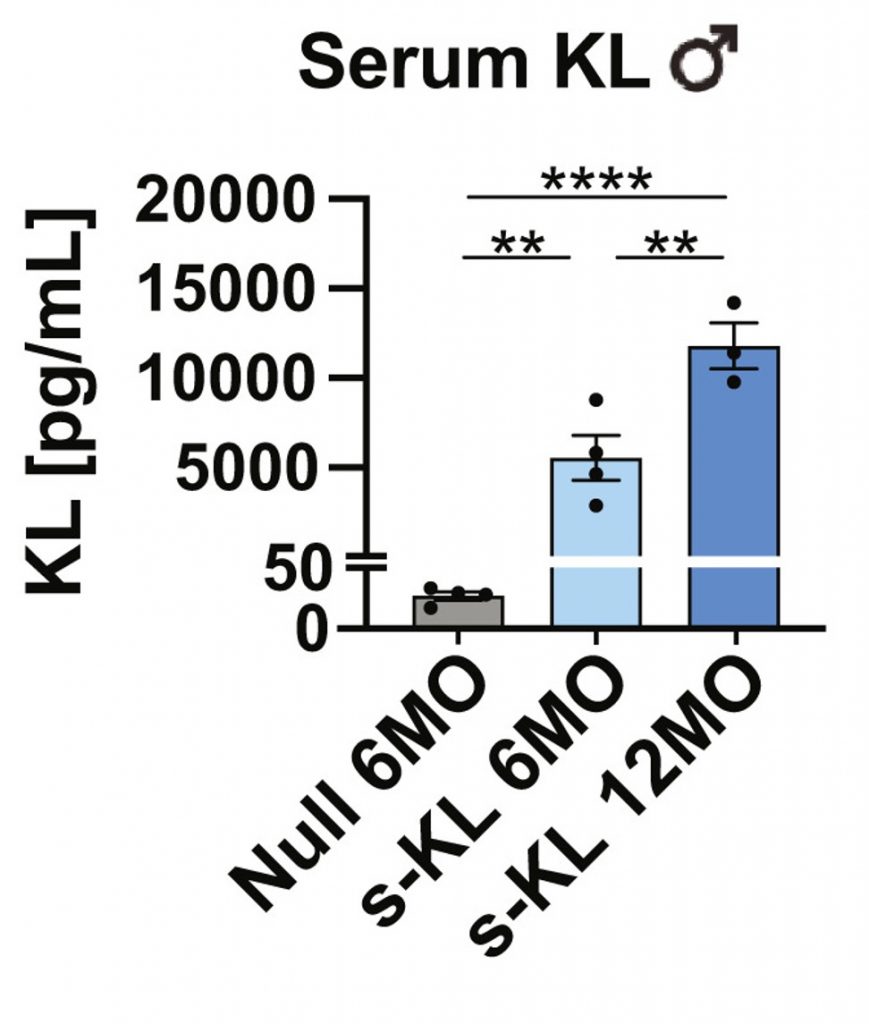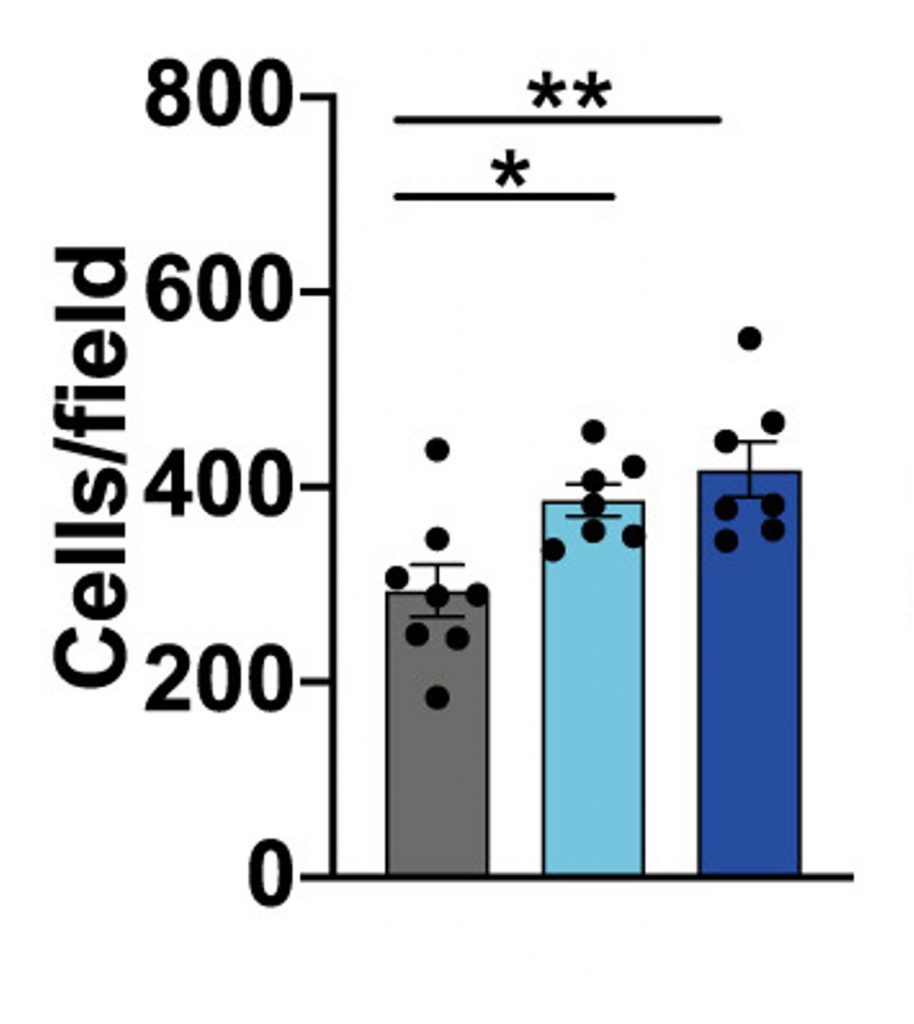Key Points:
- Klotho gene therapy prolongs the lifespan of male mice by 19.7%.
- The one-time gene therapy improves bone, muscle, and brain aging markers.
- Klotho gene therapy restores the capacity of muscle to regenerate.
The anti-aging molecule klotho has gained the attention of researchers exploring the limits of gene therapy — a technique that modifies a person’s genes — and delaying cellular aging. To do so, Roig-Soriano and colleagues injected the klotho gene into mice. They injected mice that were 6 months old, roughly equivalent to a 31-year-old human, and 12 months old, roughly equivalent to a 44-year-old human. Compared to mice injected with an empty solution when 6 months old, the mice injected with klotho when 12 months old ended up living 19.7% longer.

For some reason, the mice injected with the klotho gene at 6 months of age did not live significantly longer than the mice injected with an empty solution. The authors attribute this to lower klotho protein levels, which was observed in the 6-month-old male mice. The klotho gene was delivered in an adeno-associated virus (AAV) vector, which transports the klotho gene into cells where it is made into proteins. The authors speculate that the liver may have regenerated enough cells over the extra six months of life to reduce the number of cells harboring the klotho gene, reducing klotho protein production.

Notably, the female mice were euthanized due to skin ulcers and anal bleeding, so whether they would have lived longer remains unknown.
Reversal of Muscle, Bone, and Brain Aging
Many of the effects of klotho gene therapy on physical performance, muscle tissue, and bone tissue were sex-dependent. An exception was the ability of both male and female mice to traverse a horizontal bar. Otherwise, the male mice saw improvements in grip strength that were not apparent in females. Moreover, the female mice saw improvements in balancing on a spinning rod (rotarod) where males did not. Male mice also had larger muscle cells and less muscle damage (scarring), whereas females did not see this benefit. Additionally, female mice showed improvements in bone structure that were not seen in male mice.
As to its application to both males and females, the effects of klotho gene therapy were clearer in the brain. With age, brain cells called astrocytes, which maintain the health and function of the brain, decline. However, mice injected with the klotho gene had astrocyte numbers similar to young mice, suggesting a reversal of astrocyte depletion. Moreover, the number of neurons and microglia, which are our brain’s resident immune cells, were increased in mice receiving klotho gene therapy. Together, these findings suggest the prevention of brain degeneration by klotho gene therapy treatment.

Frankenmouse
With age, our muscles gradually shrink, partially due to their inability to regenerate. To assess muscle regeneration, Roig-Soriano and colleagues surgically transferred aged muscle into young mice. They took a leg muscle called the EDL (extensor digitorum longus) from 24-month-old mice (roughly equivalent to 69-year-old humans) and transplanted them into mice given the klotho gene therapy. As a result, the muscle cells of the aged EDL grew larger, indicating regeneration. Moreover, the number of muscle stem cells, which are necessary for muscle regeneration, increased. These findings suggest that mice given the klotho gene therapy are capable of regenerating aged muscle.
How to Increase Klotho Levels
It may be a while before we see klotho gene therapy in the clinic. Roig-Soriano and colleagues treated the mice with AAV gene therapy only one time, injecting the klotho gene directly into the bloodstream through the tail vein. However, they also injected the klotho gene-containing AAV vector into the brains of the mice to bypass the blood-brain barrier. This sort of brain surgery is likely too invasive for a standard procedure in humans. Future studies could explore different types of AAV vectors that can cross the blood-brain barrier to determine if the klotho gene needs only to be injected into a peripheral vein.
In the meantime, there are ways to increase klotho levels without gene therapy, such as exercise. One study showed that one session of high-intensity exercise increases blood klotho levels in healthy adults. Furthermore, a meta-analysis of 12 studies showed that chronic exercise increases klotho levels regardless of health condition. These studies suggest that getting regular exercise can help maintain klotho levels, which decline with age.
When it comes to diet, certain nutrients are associated with higher klotho levels, including vitamin C, folate, and fiber. Many fruits and vegetables are high in vitamin C, folate, and fiber, including oranges, kiwis, bell peppers, and brussels sprouts. Legumes (lentils, peas, and beans), nuts, seeds, meat, and eggs also contain high levels of folate. With that being said, drinking alcohol may lower klotho levels. Thus, watching one’s intake of certain foods and drinks may elevate or lower klotho levels.